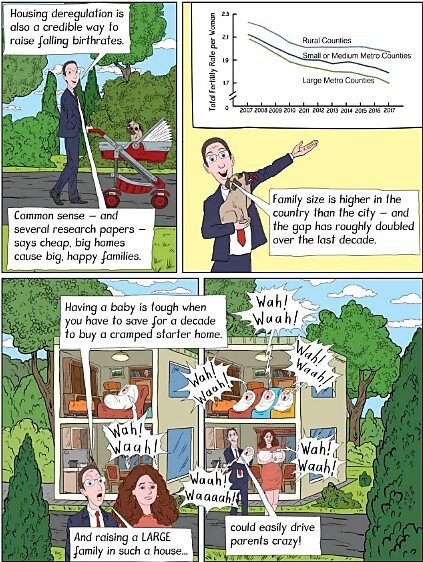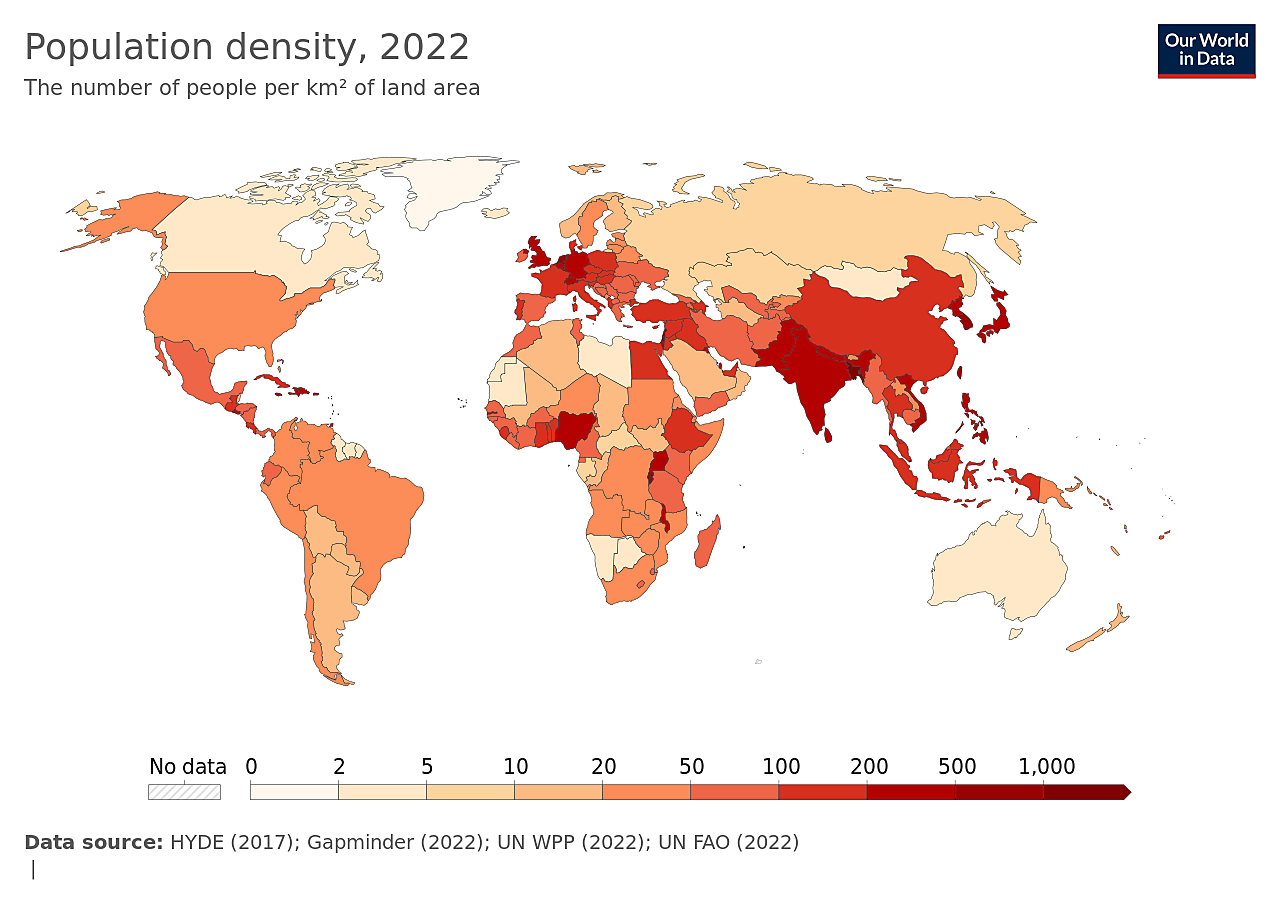If you read the endnotes for Build, Baby, Build, you’ll learn about all of the papers I could find on the connection between fertility and housing prices/housing regulation. I’m afraid the total is only three:
- Simon, Curtis, and Robert Tamura. 2009. “Do Higher Rents Discourage Fertility?” Regional Science and Urban Economics 39: 33–42.
- Mulder, Clara, and Francesco Billari. 2010. “Homeownership Regimes and Low Fertility.” Housing Studies 25: 527–41.
- Shoag, Daniel, and Lauren Russell. 2018. “Land Use Regulations and Fertility Rates.” In One Hundred Years of Zoning and the Future of Cities, edited by Amnon Lehavi, pp.139–49.
All three articles affirm that lower housing prices and/or less housing regulation raises fertility. But to be honest, the main reason I’m convinced of the natalist power of housing deregulation is not the research but common sense. Specifically:
- Higher housing prices make young adults more likely to keep living with their parents.
- Young adults who live with their parents are unlikely to marry.
- Even married young adults who live with their parents are unlikely to have kids.
I call this the problem of “basement fertility”: Living in your parents’ basement is a powerful form of contraception. Make housing a lot cheaper, and young adults will form new households — and new families — sooner.
The main doubt: Housing deregulation allows greater population density, and some smart people are convinced that density causally reduces fertility. Several people have recently waved Rotella et al.’s “Increasing Population Densities Predict Decreasing Fertility Rates Over Time: A 174‐Nation Investigation” (American Psychologist, 2021) in my virtual face. While Rotella et al. admit that their main evidence is not really causal, they appeal to animal experiments where density per se slashes fertility:
In nonhuman animal studies, higher population densities have been associated with reduced reproduction rates (Fowler, 1981, 1987). Further, experimental work suggests that this relationship is causal: Organisms downregulate their fertility rates in higher densities (e.g., Both, 1998; Dhondt et al., 1992; Leips et al., 2009; see Sng et al., 2017; for a recent review of this literature).
Later, Rotella et al. elaborate:
In this view, adaptive behavioral responses depend on ecological constraints, which can differ in high‐ and low‐density populations. Low‐density environments are often characterized by high resource availability per individual, and lower intrapopulation competition for resources. In such conditions, it is more adaptive for individuals to exploit resources at a faster pace, to reproduce earlier, and have more children. In contrast, in more dense environments, there is greater competition between individuals. For individuals to compete successfully in such an environment, one needs to build relevant skills and knowledge, which in turn delays reproductive efforts. Moreover, it is likely that in high‐density contexts, offspring also require more investment to become competitive enough to survive and reproduce. Thus, it is comparatively more advantageous to invest more heavily in fewer children in population‐dense environments.
If you actually read Rotella et al., you’ll find that they measure population density at the national level. Get a country’s total population, divide it by the total land area, and you get their density measure. Which yields something like the following global map:
A few critical remarks are in order.
- If animal experiments are your inspiration, national population density is a bizarre measure. Should we imagine that Muscovites will have lots of kids because their country includes millions of square miles of Siberian emptiness? Animals don’t care about populations beyond their fields of vision. Should we expect humans to be so different?
- Even if you take Rotella’s approach as gospel, their paper simply has zero to say about housing or urbanization. Packing your people into fewer houses or taller buildings doesn’t change national density, which remains total population divided by total land area.
- Suppose we switch to a more localized measure of population density. The fear that deregulation will raise this measure of density and thereby reduce fertility is now coherent. But is it correct?
a. “High housing prices suppress fertility” starts with a strong presumption in its favor, and has a clear policy implication for natalists: deregulate so prices fall and fertility rises.
b. Much of the observed correlation between local density and fertility is clearly reverse causation. People who want large families tend to move to spacious housing; people who don’t want large families move to pricey downtowns.
c. “Density suppresses fertility” and “High housing prices suppress fertility” are very hard to distinguish empirically. After all, why do urbanites live in such small places? In large part, because large residences in urban areas are extremely expensive. Imagine, though, that a 5000 square foot apartment in Manhattan rented for $1000 a month. Should we really think that New Yorkers wouldn’t spring for the extra elbow room? And once they have this extra elbow room, will the fertility effect really vanish because they’re too high off the ground?
d. I do not claim that housing prices are the only factor that shifts fertility. Culture matters, foresight matters, and contrary to what you’ve heard, so do baby bonuses. But as far as I know, dense cities with cheap, spacious housing simply don’t exist in the First World. And under laissez‐faire, they probably would.
e. On balance, full deregulation would very likely increase urbanization. As I’ve explained before:
Current regulation strangles urban construction, and heavily restricts suburban construction. If you got rid of this regulation, skyscrapers really would start going up all over high‐priced cities – and millions of urban commuters would swiftly relocate to occupy these new buildings. Families with children would naturally be less‐eager to go urban, but even they might be tempted by large, cheap apartments across the street from their jobs.
Plenty of other folks would respond by moving into all of the newly vacant – and suddenly cheap – suburban homes. This could conceivably fully satisfy suburban demand, but the more likely result is that developers would also take advantage of deregulation to subdivide existing lots and build lots more single‐family homes. And of course other developers would buy up neighborhoods of old single‐family homes, bulldoze them, and replace them with massive cheap apartment complexes.
f. So would deregulation raise or lower density? It depends on the measure. Any localized measure that takes population and divides it by land area will rise. Even in suburbs, because a deregulated world would abolish minimum lot sizes. But a more sensible density measure like “indoor living space per person” would likely plummet.
To be clear, housing prices probably aren’t the main cause of falling fertility. I put more blame on laborious parenting philosophies, intermediate foresight, and absurd credential inflation. But cheaper housing would almost surely help, and freeing housing markets is the best known way to make housing cheap.































